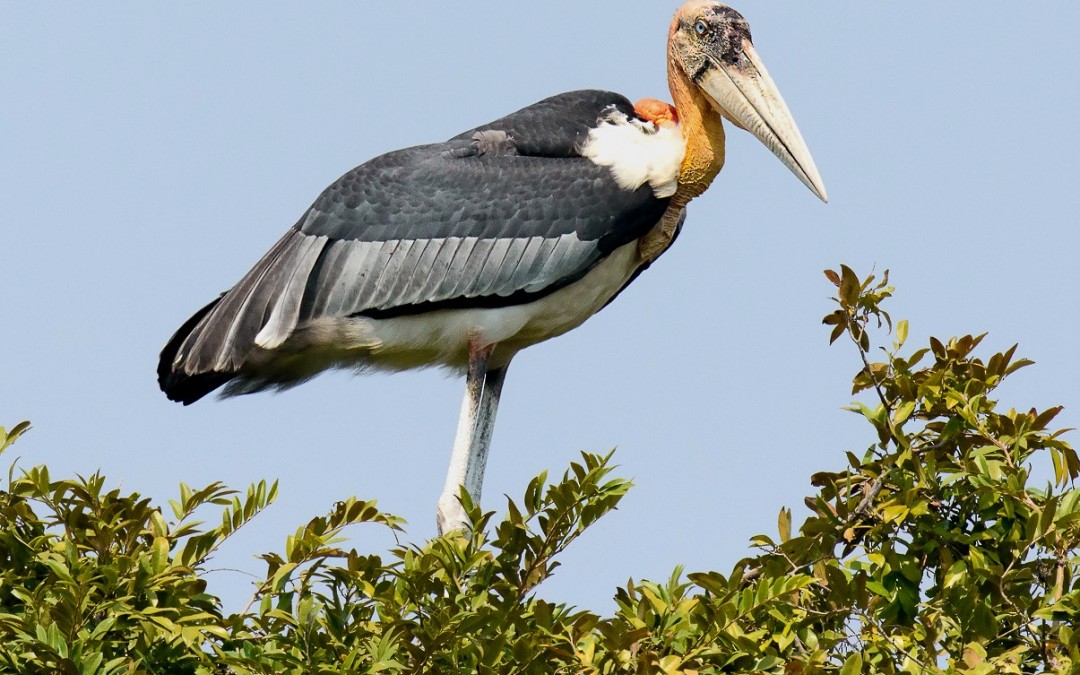
by Nick | Feb 25, 2021 | Blog, Conservation, Kayak, Uncategorized
Prek Toal on finfoot
The incredibly rare milky adjutant lived in Prek Toal and it was my mission to save it even before I got to Cambodia and realized there isn’t a milky adjutant it’s a Milky Stork and a Greater Adjutant. Undeterred enthusiasm intact, Prek Toal was at the heart of why I’d come and where I was going.
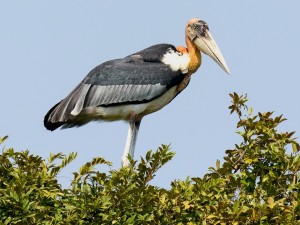 Greater Adjutant inside the Core Bird Reserve.
Greater Adjutant inside the Core Bird Reserve.
The Core Bird Reserve did not disappoint. A two hundred square kilometer water world of open forest emerging from The Lake during the ebb, it seemed untouched and unvisited. A haven for the flocks of large birds that flew past our boat; pelicans soaring high on the thermals or sailing galleon like across the lake. Oriental Darters and cormorants flying in formation, plunging into the water with their spear like beaks to pluck out fish. And the storks perfectly poised in the tree canopy, ruled over by the largest of them all, the Greater Adjutant.
Over 200 species have been recorded inside the core bird reserve so every size, shape and color has adapted to take advantage of the hierarchy in the flooded forest.
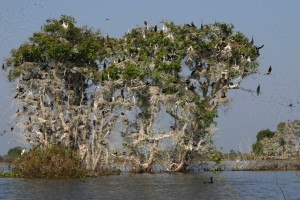 Cormorant and Oriental Darter colony with their white chicks. Photo Nick Butler
Cormorant and Oriental Darter colony with their white chicks. Photo Nick Butler
Prek Toal Village is fantastic in its own right, hundreds of wooden houses floating on clumps of bamboo clustered along the river banks in the dry season when the lake is low or spread out into the forest during the flood. The village economy revolves around fishing; subsistence for the poorer families in the floating shacks. Midscale for those that can afford the apparatus and the bribes to fish inside the core bird reserve. And commercial where migrants work for the Bong Thoms (powerful people) with fishing rights to the Lake. In February the fish fences fringe the flooded forest to trap the fish as they emerge from their sheltered nurseries beneath the trees.
Life on the lake is dictated by the annual pulse of water surging down the Mekong River. Silt caught in the current is carried from China through Myanmar, Thailand and Laos then deposited where the water slows South of Phnom Penh. The raised riverbed changes the direction of the flow from South to the sea now North to the great Tonle Sap Lake, filling it like a bath until the King pulls the plug at Bon Om Teuk, The Water Festival and allows the river to regain its normal route.
 Prek Toal Village during the flood. Photo Nick Butler
Prek Toal Village during the flood. Photo Nick Butler
The flood brings life in the form of fish that swarm into the flooded forests of Prek Toal to breed, spawn and grow providing much of Cambodia’s protein.
What can we say to our guests when we take them across the lake from Siem Reap to The Core Bird Reserve and Prek Toal Village?
We can explain the hydrological phenomena at the heart of the ecosystem and describe the adaptations both human and natural but it’s best to let people see for themselves and watch the wonder of this other worldly place work its magic.
That’s the scene set for our trip with Discovery Magazine onboard finfoot to capture the essence of what makes this place so special. Sally had come to look beautiful. Sam was there to photograph her looking beautiful. Daniel was there to write about her looking beautiful. The Core Bird Reserve and finfoot with logistical assistance from Indochine Exploration was the reason she looked beautiful, and incidentally why I was there.
It’s not easy to take a boat inside the Core Bird reserve but Buntha and Bo had persuaded the conservation team in Prek Toal to let us in. So we sailed through the trees to where Wildlife Conservation Society has built platforms in the canopy to monitor and protect the bird colonies. The water was at its height so we could see the submerged vegetation and the fish that swam between the leaves beneath us. It was too early in the year for the star of the show, the milky adjutant AKA greater but the trees were laden with black and white colonies of darters and cormorants with their creamy white chicks.
We paddled back in our kayaks over the yellow mats of saray, a tiny floating flower to where the water hyacinth clogs the channels into Prek Toal.
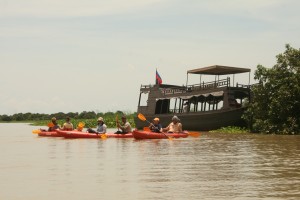 Kayaking at the edge of the Core Bird Reserve from finfoot. Photo Nick Butler
Kayaking at the edge of the Core Bird Reserve from finfoot. Photo Nick Butler
Clearing a route through the weeds we made it to The Sangke River and paddled across to The Saray Platform where the women of the village weave the dried stems of this invasive alien into handicrafts that are sold for the benefit of the poorest families in the village. There’s also a restaurant, you don’t have any choice, its fish fresh from the lake with vegetables and fruit traded from Siem Reap.
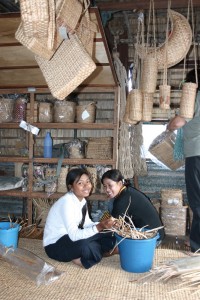

Women from Prek Toal Village weaving the stems of water hyacinth into handicrafts on the Saray Platform. Photo Nick Butler
We were sailing on finfoot, so we forwent the fish and rice in favor of lightly poached chicken and roast vegetable salad back on board.
The kayaks stowed and all aboard we stretched out luxuriously across the day beds on the upper deck, shaded by a canvas awning while the staff laid out our lunch boxes complemented by a chilled Chenin Blanc.
We’d been to the ends of the earth, a forest of flooded trees circled by flocks of birds. We’d paddled through a village untamed by time, as mesmerized by the villagers as they were by us.
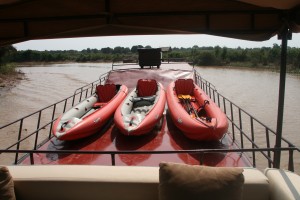 Kayaks stowed on finfoot
Kayaks stowed on finfoot
Indochine Exploration creates a very special day onboard finfoot. The Core Bird Reserve is Indochine Exploration’s flagship adventure, uniquely exploring this pristine environment by kayak with conservation experts.
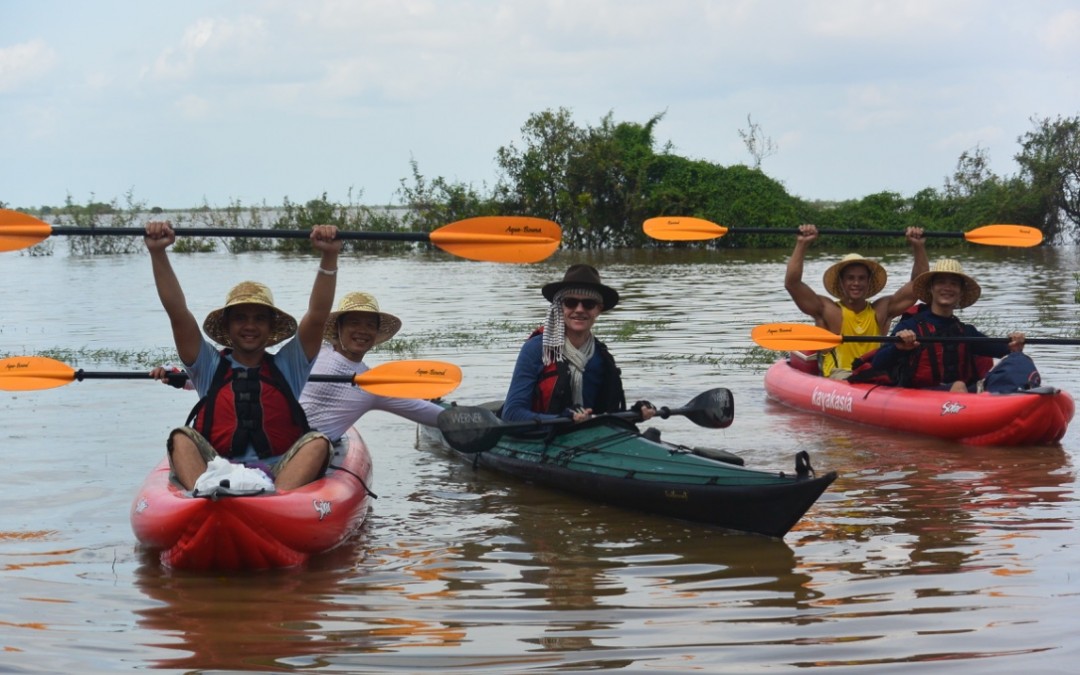
by Nick | Sep 12, 2020 | Blog, Conservation, Kayak
All adventures start with an extra hot latte crafted by Mex at the Little Red Fox Coffee Shop and the morning crew; Jady – temple water management and Darryl the Angkorian historian.
Feathercraft kayak on top of Dy’s electric blue Highlander, Solar kayaks, Lors, Bunthy, Visoth and me inside, another latte then pick up Buntha on the way to the lake.
Our route decided last week when we climbed out of REP Airport on our way to SIN (gapore). Five thousand foot above Phnom Kraum we could see pockets of bush surrounded by a sea of water and not the usual other way round. Direct channels lay clear to the open lake and onto the floating village of Prek Toal.
We launched where the water lapped Phnom Kraum Hill, Bunthy together with Lors, Visoth and Buntha. Laden with dinner and drink, two bladders of wine for the boys and merlot in the cool box for me.
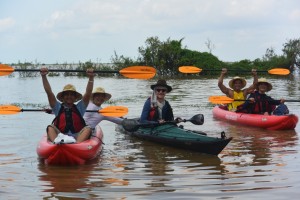
From left to right; Visoth & Buntha, me, Lors and Bunthy
My Werner paddles were so light I barely felt them kissing the water as I effortlessly slid across the lake. The two Solars exploded with muscle like a moon rocket launch then stalled as Bunthy paddled one way and Lors the other. Buntha and Visoth quickly found a rhythm. Fizzing with excitement we set off for Prek Toal.
The lake was not quite so high that we could paddle unimpeded. Lead by lines of vegetation, fishing nets caught in the Solar fins as we zigzagged across the floodplain.
Past midday and Bunthy was running on empty, ‘when are we going to eat?’ He whimpered, while Buntha and Visoth the buffalo paddled on regardless of hunger, fishing lines and fences.
We entered the forest at the edge of the lake and moored to the branches beneath the canopy near the tops of the now submerged trees. We perched on the branches and ate lunch. Lors the gibbon swung from an outlying limb.
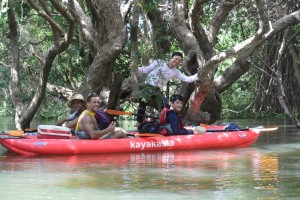
In the canopy forest at the edge of the lake
Climbing down from the tree trunks we made ready for the lake crossing just as the wind died and left barely a ripple on the dull grey expanse of water. The calm made a mockery of my safety briefing. ‘Tie down the equipment, stick together and wear life jackets.’
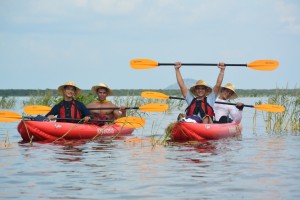
Above and below, Phnom Kraum behind, Prek Toal ahead

Lors inevitably started the horseplay by sitting up on the cool box at the back of his and Bunthy’s kayak nearly capsizing them both. They couldn’t get a rhythm going but his massive muscles powered through despite their lack of technique.
A huge cloud lay heavy over Prek Toal cumulating and shifting like an upset stomach. All the while darkening until the three telephone masts that marked out the village punctured its nebulous vapour releasing a wind that held us stationary and blew off my Akubra hat.
Bunthy and Lors’s calls for five minute breaks were becoming more frequent and faint as Buntha and Visoth, apparently unfatigued paddled on while I just sort of glided.
The whiffs of decomposing fish from the prahoc platforms and the reverberating staccato of the two stroke long-tail engines reached us before we got to the floating shacks at the edge of the village. We paddled between the more substantial houses buoyed up on clumps of bamboo lining the main channel.
Buntha’s pool hall, floating garden, crocodile cages and Mother in Law’s house lay opposite. ‘Do you want a shower Nick? Buntha asked me. ‘Not in your shit!’ The lake was high so well diluted but the crocodiles and Buntha were defecating on one side of the house while the family bathed on the other. I got back in the kayak and paddled away from the village with a bar of soap, managing to wash myself standing on the branches of a submerged tree.
The boys played pool, I scribbled notes then the family emerged from Mother in Law’s house with our dinner. Bunthy had bought plastic skins of cheap vinegary red wine, I’d put a couple of bottles of Chilean merlot in the cool box, which rapidly disappeared when Buntha found out how much nicer they tasted. We finished dinner. The alcohol combined with the day’s exercise, rounded off by five mg of Valium left me contentedly numbed. I turned off the Mother in Law’s radio lay down next to the crocodiles and fell asleep.
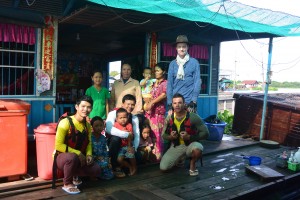
Saying goodbye to Buntha’s Family (excluding the Mother in Law)
A horrific fire had burned for day’s leaving half of the Core Bird Reserve reduced to charcoal. We paddled between the blackened branches saddened. The irrepressible Lors quickly diverted our attention and the presence of any wildlife with the continual noise he emitted.
The fire was an environmental disaster but still the floodplain is a wonderful and alien world of water and blissful quiet, excepting Lors.
Dy was waiting with his ice cold Highlander at Maichrey. It was past noon so rice was the priority. We diverted via the Baray now swollen with rain and a bamboo platform over the water for road kill chicken rice and tamarind paste, a look of total exhaustion on the boy’s faces. It had been fun!
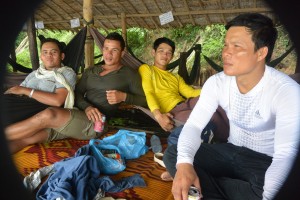
Exhausted waiting for lunch at the West Baray
We are very pleased to take our guests on a day trip by motorboat to the floating village of Prek Toal with an early morning boat journey in the seasonally flooded forests of The Core Bird Reserve. On the return we explore the village by kayak with lunch on a floating platform then paddle to Buntha’s house and meet his family (and crocodiles).
If you have a bit more time an overnight stay means you start to get a glimpse of what life on the lake is really like. And we’d be delighted to paddle with you all the way if you’re up for the challenge!
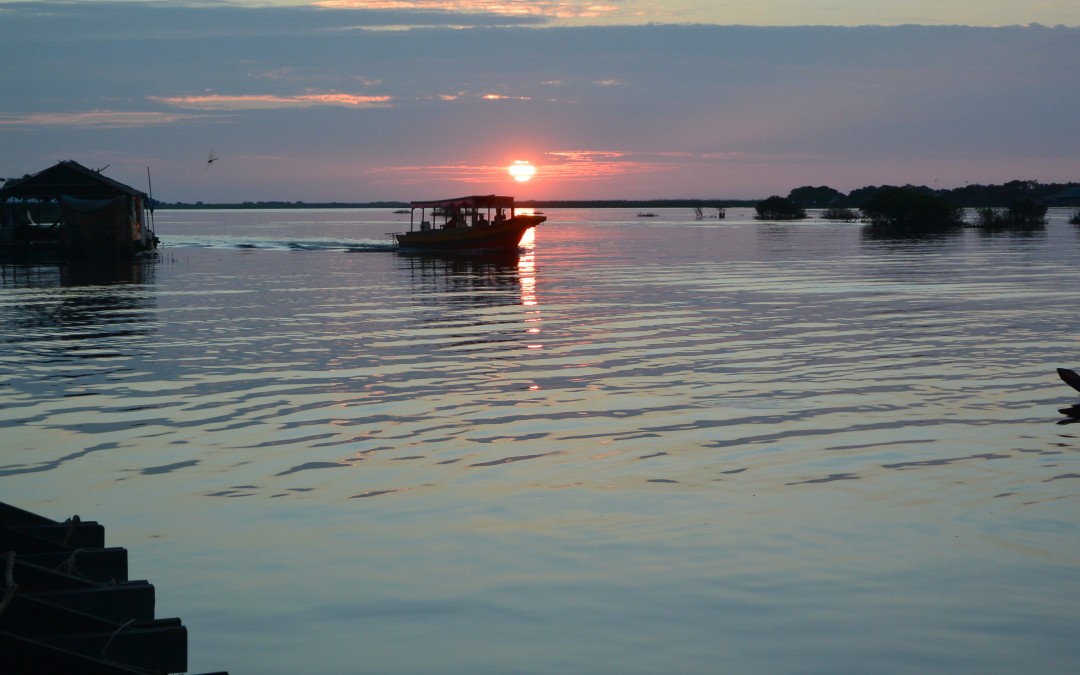
by Nick | Apr 2, 2020 | Blog, Cambodian Journeys, Conservation, Culture, Kayak, Uncategorized
Lena & Seb’s Battambang Adventure
Day 1
Vans, big motorboats, little motorboats, kayaks, bicycles, trains and taxis all had a part to play in our adventure on route from Siem Reap to Battambang. Overnight in the floating village of Prek Toal and the flooded forests of the Core Bird Reserve. Across the floodplains of the Tonle Sap Great Lake and up the Sangke River through the lush rural countryside of Battambang Province to the centre of the farming town in twenty four hours and a bit.
The expedition started at the boat station near Maichrey floating village, where Mr Heang and Finfoot, our comfortably converted fishing boat were waiting. The water was still high enough for us to cross the flooded scrub where we moored to a submerged tree. Lena and Seb were apt pupils as I explained the hydrological phenomena of the Mekong River system until I was rudely interrupted by a virulent green pit viper wrapped around a branch overhanging the deck.
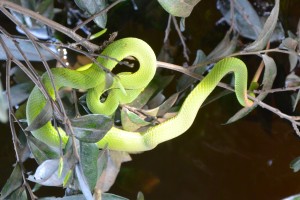 Pit Viper in tree beside boat
Pit Viper in tree beside boat
The afternoons adventure was to explore Prek Toal floating village and the surrounding flooded countryside by kayak. The police chief took photos as we paddled past his station, children came out to stare as we floated by their houses, while those who were working ignored us.
Our improvised route went between the blackened trunks of flooded trees, under their dense green canopy and emerged beside the floating Catholic Church. We crossed the channel to where a muscled boy was ladling fish into piles in front of squatting ladies who chopped them up with meat cleavers, making a pulp that would ferment into Prahoc or Khmer cheese. So named because it stinks.
 Seb and Lena setting off from their homestay
Seb and Lena setting off from their homestay
We watched the sun – a blood red orange, set over the Core Bird Reserve from the watchtower on top of the environmental research station, then motored over to the Saray Platform for supper.
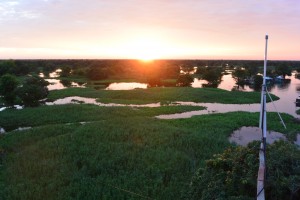 Sunset over the Prek Toal Core Bird reserve
Sunset over the Prek Toal Core Bird reserve
Reflections twisted by the wake of motorboats, a cool breeze playing over the boat’s spume.
Hosing the prahok tables ready for tomorrow. Alien clumps of hyacinth drifting on the water.
Single pin pot lights overly bright in the blackness.
Cotton wool fluff of half seen cloud and the glare of a television set as we came close to people’s houses.
The women weavers on the water hyacinth workshop had gone home but their piers were cooking us a supper of fish, vegetables and fruit with rice and a good bottle of chardonnay to wash it down.
Swinging in a hammock in Veasna’s house our home for the night. Manus hid a lime in Baby Buntha’s nappy. His sister heaved the heavy little lump across the floor. The Mother in Law busied herself with not much. The Grandmother on all fours played with the baby. Little sister went skipping to her mummy then wrapped the baby in plastic, all the while pool hall play by the lads in the village. Hide and seek by the water jar, doubled up Grandmother.
Day 2
Streaky orange lighting the village as the first long tails cacaphonic clatter echoed across the water, the old lady hawked, the batteries ran out on the night lanterns. We awkwardly crossed the tilting boats to the pool hall barge to meet Heang, who took us for breakfast back at the Saray Platform.
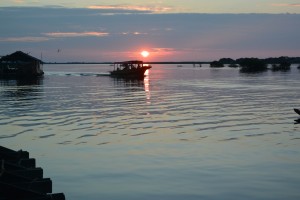 Dawn over Prek Toal
Dawn over Prek Toal
Bunhoeurn was waiting in the community boat for the ride into the magical landscape of the post dawn flooded forest. The light of the warming sun reflected by the delicate yellow flowers of floating saray plants. Squadrons of cormorants flew in slip-stream formation. A profusion of black and white; Oriental darters mixed with egrets, pelicans riding the thermals like galleons in the sky and the bird colonies. Avian cities built in the tallest trees.
Back in the village by 9am our journey into the heart of darkness (actually lush, pastoral Battambang) began.
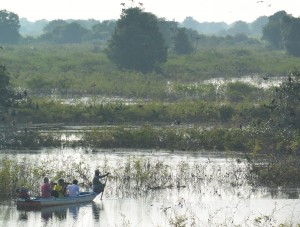
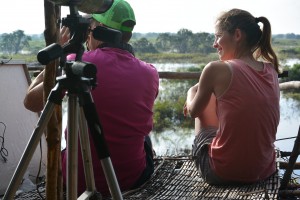
The core bird reserve & view from observation platform
The waterway was fringed by hyacinth and undulating green margins of scrub with the occasional hamlets of floating houses or shacks tied to trees. The first proper village was Kampong Prahoc, which sort of translates into waterside place of good fermented fish paste. I wouldn’t want to be there when the water is low and rotten fish undiluted!
After an hour or so we began to get an idea of how vast the floodplain is. Over 40 kilometres wide where the water rises and falls by 10 meters submerging all but the tallest trees. In the floating villages along our route the only permanent constructions were pagodas on stilts.
Around a bend and Wat Cheu Khmao or temple of the black wood, came into view like a Burmese monastery with a beautiful modern pagoda framed by sugar palms behind. It was built in 1944 copying the Bayon Temple in Angkor and completed with Loksvara, the smiling faces at the cardinal points but they were blamed after accidents and disease struck the village then removed.
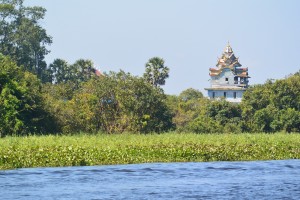 The salapali or space for teaching of Wat Cheu Kmao
The salapali or space for teaching of Wat Cheu Kmao
Great clumps of yellow green bamboo towered over the floating houses. The stems are harvested to provide the floating platforms on which the villages are built.
A regal Grey-headed fish eagle on guard beside its nest in a tall tree, while on a lower branch a hunched up night heron the servile vizier to the magnificent bird above.
We passed a tacky tourist lunch stop as bad as any bus station for the back packers crammed inside and on top of the fibreglass tourist boat.
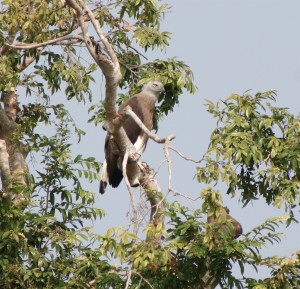 Grey-headed Fish Eagle
Grey-headed Fish Eagle
A single file short cut through the scrub, stopping for long tail boats loaded with beer and rice and wooden boats with giant water jars. We emerged onto an open plain where the trees had been cut down. Home to a transient people living on their small house-boats or shelters on the river bank as the water receded. Strange pivoting bamboo fishing nets were lowered into the water then raised revealing a whicker basket tied to the bottom to trap the fish.
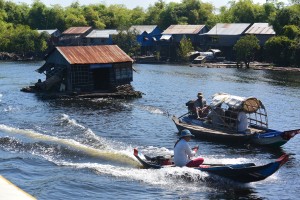 A floating house being towed to deeper water through a village of stilted houses
A floating house being towed to deeper water through a village of stilted houses
A fat pelican sat on the porch of a floating house. An unhappy monkey ran around on a chain in the full sun on a bamboo fishing platform and a full grown otter seemed ok as it scampered round the girl who held it’s leash.
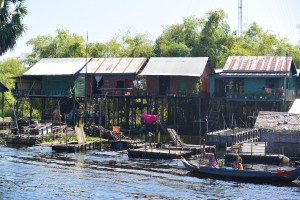 The stilted houses lining the still flooded banks of the middle Sangke River
The stilted houses lining the still flooded banks of the middle Sangke River
Telephone masts were visible in the distance. Riverbanks rose above the water and motorbikes parked beside houses. We’d reached the upper Sangke.
Beautifully painted pagodas in stark contrast to Cham mosques. Elegant stilted wooden houses with tiled roofs between sugar palm and kapok trees.
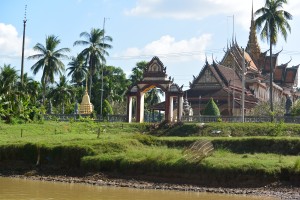 A pagoda on the riverbank not far from Battambang
A pagoda on the riverbank not far from Battambang
Lena and Sebastian safely delivered to their garden enclave in Phum Wat Kor upstream of the town, I breathed a sigh of relief as the extra hot, double shot latte created by Chenda was placed on the little wooden table in front of me at Knyei Cafe.
Twice cooked beef with Seb and Lena at Jaan Bai cooking school restaurant then Jamesons and bed.
Weddingitis had infected the town and the Seng Hout Hotel where we’d booked to stay had a particularly virulent attack so we kept on going to find another bland box like building with half the Cardamon Forest used to make the furniture but ice cool rooms with no aesthetic distractions to sleep.
Day 3 The Battambang bicycle tour of the city with San.
First stop gold, bras, wigs, fruit, meat & fish, the crammed Psa Thmei or new market, built by the French.
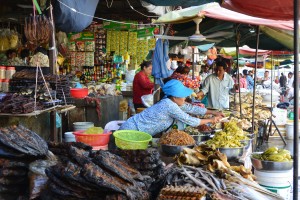 Psa Thmei
Psa Thmei
We crossed the quayside and down the dry banks to the ferry man who took us across the river to the monk school at Bovil Pagoda.
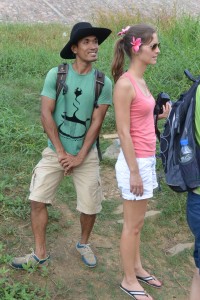
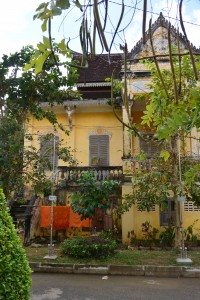 Manus & Lena crossing the river and a monk house at Bovil Pagoda
Manus & Lena crossing the river and a monk house at Bovil Pagoda
Singing rang out from the Catholic Church, which had the enthusiasm of an American black baptist congregation not the stilted formality of a Catholic communion. Time was getting short and the Bamboo Train beckoned so we had to forgo the black man in the middle of the road, another of Battambang’s attractions.
Giant wood spiders had weaved their webs over the rail tracks. The view extended across bright green rice fields to Phnom (hill) Sampeou in the distance.
A one-way system, lift off the bamboo platform, remove the axles and let the oncoming norrie through before putting it back together again.
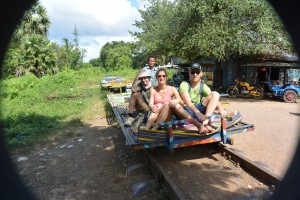 Nick (left), Lena & Sebastian on board a norrie
Nick (left), Lena & Sebastian on board a norrie
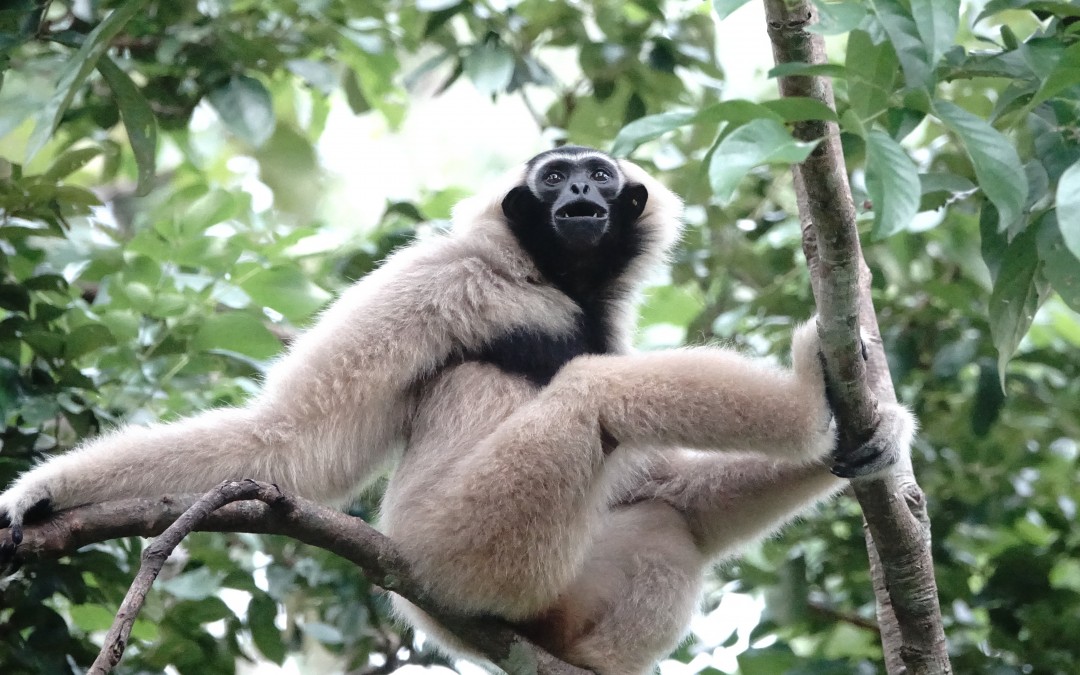
by Nick | Oct 11, 2019 | Bike, Blog, Conservation
A BeTreed Blog or The Adventures of BeTreed
BeTreed by myself in January 2017 (A BeTreed Adventure; https://indochineex.com/blog/a-betreed-adventure),
Then the Phnom Tnaut hike with Buntha and the boys. Hiking in the hills along snake trails and dodging trees while hanging from a zip-line.
And now retracing the forest paths to Preah Khan that we’d cycled with Laura and Ra.
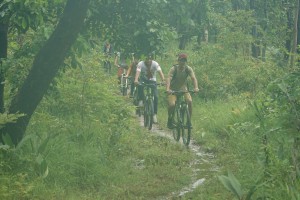 Manus leading the group on the forest path to Preah Khan
Manus leading the group on the forest path to Preah Khan
This time with Manus, my partner. I want to see the forest, he said. Buntha and Sreymom, my colleagues and friends – also wanted to come, then Veasna Buntha’s wife and Pov, the van driver, what was he going to do while we were playing in the forest? And finally Mengly the chef, we had to eat so he was welcome.
BeTreed is a lodge that Ben and Sharyn built from fallen timber, where guests can stay (including the fabulous tree-house) to experience the 6000Ha of community forest that Ben is protecting with a few rangers. It’s in the middle of a fast contracting no-where that’s difficult to get to in the dry season and now the rain is here it’s nigh impossible, as we found out.
There’s not much time, said Ben. The waters coming, he added. It all seemed to be going so well. NR6 was clear and Stoung within easy reach of Siem Reap. The new red earth road North had actually been paved most of the way. No rain, no wrong turn through three provinces all the way to the Preah Khan Baray, though we shouldn’t have been at Preah Khan or its Baray.
It was at this point the rain did come. A gentle drizzle at first but before long the clouds were spewing great blobs. We rang Ben but that didn’t help much. I can’t understand what he says face to face but over the phone impossible. Go back to the main road, which main road? The one you were on. That didn’t help. I tried a different tack, which village should we head for? Ben speaks better Khmer that English so I gave the phone to Buntha and we seemed to be on the right road for Ta Bos Village. That’s what I asked!
Ben was waiting in the village with his new pickup truck from the Ministry. We’ve got to go. We threw five of our bikes plus enough food to last a month, which was probably how long we’d be there if it didn’t stop raining, into the back of the truck and set off along the dirt track. Pov was locking up his van and had to run, jump and was caught by Manus and Mengly.
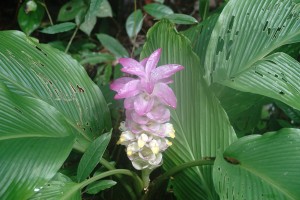 A forest flower
A forest flower
Buntha and I cycled crazy into the rain fuzzed night after the diminishing tail lights scared we’d loose the way.
We thought the car had sunk under the first torrent we crossed just in time to see it emerging on the other side. Energized we followed along the forest track to BeTreed. Drainage ditch planked crossings, rocks and fallen logs we couldn’t see. The trees blanked out what little light there was. Spasmodic bursts of lightening lit up the dark. Where the road turned we carried on into the bush then made a wrong turn. What to do lost in the forest in torrential rain?
Eventually after retracing our route the welcome chaos of BeTreed beckoned and we climbed the steps.
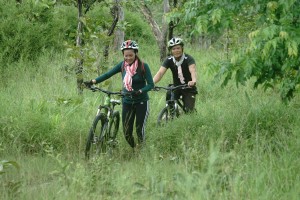 Veasna and Buntha
Veasna and Buntha
Buntha and I made puddles, Pov hovered while Mengly directed Sremom, Veasna and Manus as they sliced and chopped their way through the ingredients of dinner, which was spread out across the table as a vast array of food. I made introductions to Ben, Buntha and Sreymom who work with me, etc. and Manus. The relentless rain just kept pouring. Only 5% chance of precipitation today according to the forecast but more like a hurricane’s hit us, said Ben.
That didn’t help as we made our way up the hill to the tree house along what was now a river. At ten meters high there was a fair chance that the water wouldn’t reach our platform but it was doing its best to get through the roof, which sounded like a kettledrum from exploding water drops and thrashing branches.
We must have slept when the rain stopped and woke to a sodden forest so saturated that many of the branches were broken.
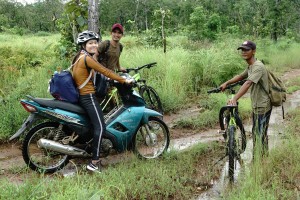 Sreymom, Manus and Try our guide
Sreymom, Manus and Try our guide
The forest was lush, it almost wobbled as we cycled. Mud filled ruts caught our wheels and prevented pushing the pedals. A dripping landscape of infinite biodiversity, Manus and Mengly who were leading the way saw a family of pigs. Sreymom fainted and traded her bicycle for Try, our guide’s motorbike. He followed ready to push her out when she got stuck. Veasna harrumphed and Buntha waited for her.
We left the forest into an illegal chamkar or cashew nut clearing. After Ben and his team cut down the saplings the farmer sprayed it with a sabotage of Roundup in 2017. Despite this it was already sprouting the green precursor to a forest.
Manus the self declared best biker was near the front at least until he got indigestion from eating too much, which coupled with exhaustion from the day meant he was going to die that night.
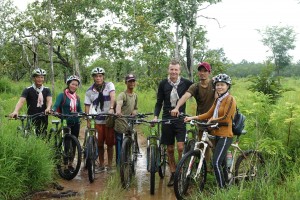 Left to right; Buntha, Veasna, Pov, Try, Nick, Manus and Sreymom
Left to right; Buntha, Veasna, Pov, Try, Nick, Manus and Sreymom
The hard exercise scarcely dented Try our guide. Also Mengly our chef appeared unfazed. I was tired and aching but kept going.
 Prasat Preah Steung, part of the Preah Khan complex of temples
Prasat Preah Steung, part of the Preah Khan complex of temples
Finally we reached Ta Siem, the gastronomic capitol of Preah Vihear and had a nice omelet and cold beer in the local restaurant, while a child watched War of the Worlds set against a muddy market.
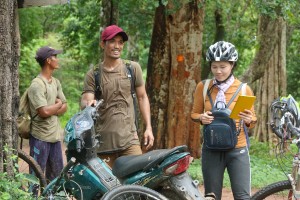 Manus soaked in sweat after the ride
Manus soaked in sweat after the ride
We cheated and sent Pov ahead to fetch his van so we could look out over the soaked countryside from the comfort of the aircon vehicle in contrast to a mud clogged mountain bike.
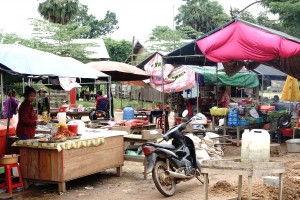 Ta Siem Village where we had lunch
Ta Siem Village where we had lunch
We regrouped at Ta Bos Village only to be met by a lake on the other side where the day before there had been a river. There was a bridge that Ben had built with most of Ta Bos village but not the owner of the paddy field, which you had to go through to get to it. A push me pull you of gods and demons as good and evil see-saws back and forth. There is no good that cannot be bad and visa versa (see Churning of the Sea of Milk. https://indochineex.com/blog/churning-sea-milk).
The thugs that helped Ben build the bridge later wanted to burn down his house. The paddy field owner thought only about her field and not the rest of the village.
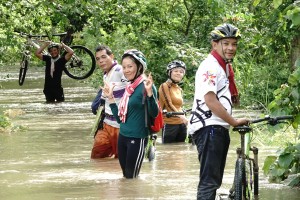 The ‘road’ from Ta Bos village to BeTreed that we’d driven the night before
The ‘road’ from Ta Bos village to BeTreed that we’d driven the night before
That was the easy part. The next flood had no excuse. There hadn’t even been a river the day before. But still we had to wade through, floating our bicycles across then return for the motorbike. Unsurprisingly the engine like everything else was flooded so we sent for Ben and his tool.
After a ‘cup o tea’ and a blissful bath in that empty period before dinner when we should have been supping a cold beer, I asked Ben to tell the story of Ta Bos Village and the Rosewood Tree.
Dense slow growing trees with a rosy tint to the wood and incredibly valuable, there was one big one left. They tried to cut it down with a handsaw but it was too dense so they came back with a chainsaw. Ben found it the next day and placed his rangers around the fallen trunk to catch the loggers when they came back to collect.
A tree so valuable was such big news a timber merchant got to hear of it and offered Ben $100,000 if he could get it legally signed off by the MoE. The provincial governor and minister agreed that Ben could sell the tree and use the money to help the local community.
 Carrying the motorbike across
Carrying the motorbike across
Back to the gods and demons, the commune chief wanted it for himself so he whipped up the local thugs who surrounded BeTreed and threatened to burn it down with or without Ben’s family inside. Ben called the governor who sent an army of military police with guns, which scared the thugs. They burnt the forest as they left.
Give it to them, said the governor. The commune chief and his thugs got the tree, sold it for a fraction of what it was worth and kept the money. It’s a daily battle that Ben wins while he can pay the police but he’s running out of money, what next?
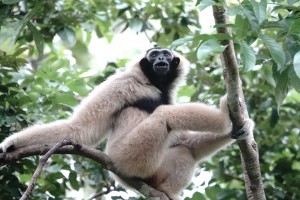 Molly the Pileated Gibbon
Molly the Pileated Gibbon
Too much! The table groaned under the weight of food, the team groaned with indigestion and Micky the three legged dog groaned with delight as copious left overs made their way onto the floor.
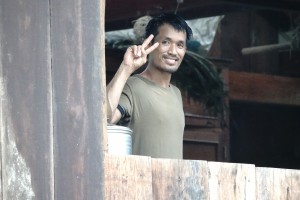 Manus the other gibbon
Manus the other gibbon
Palming a beer or two Manus and I left for the tree house, ten meters up amidst the forest canopy and now calm in the quiet evening after the crashing rain last night
The calm didn’t last as Manus woke me for the third time with a plaintiff plea for medicine. We traipsed down the hill past a poised pit viper to the lodge to get our first aid kit. Just give him Paracetamol said Ben when we woke him, which meant go away. Combined with Valium and Ibuprofen it was enough to make Manus pass out, snore all night and wake refreshed.
Breakfast was another enormous meal. Don’t eat too much. Can I cycle? No you were dying last night. Ben took those that didn’t want to ride and their bikes in his truck with the idea that he’d drop them off at the high tide’s edge. As fast as it had come up the water had receded so he drove through to the village.
I glowered at any young man who came into eyeshot and felt that no one gave a fuck about anyone else or anything. Like the emaciated dog that got caught under Ben’s truck and now lay in the middle of the road with its brains leaking out. Even Try who’d been my hero the last time I came now won’t work for Ben after he’s taken guests and got a tip.
I swallowed a big lump after Ben had dropped us off in Ta Bos village and said goodbye. The enormity of what he’s trying to achieve for people who don’t care struck home. Uncouth certainly but a hero who dedicates his life for what he believes in; conservation, biodiversity & beauty when the world seems set on greed, destruction and uniformity.
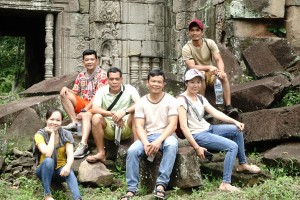 The Team at the East Entrance to Preah Khan including Mengly (2nd left)
The Team at the East Entrance to Preah Khan including Mengly (2nd left)
Preah Khan -Kampong Svai (that’s where it is). We got here yesterday but were too tired to take in the temple. JVII’s first, he built it while amassing an army to oust the revolting Cham from Angkor. (read https://indochineex.com/blog/angkor/story-jayavarman-vii-told-temples)
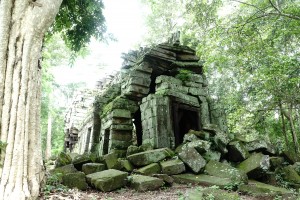 Inside Preah Khan
Inside Preah Khan
Ta Prohm with its twisted tree roots and Beng Melea with its meandering boardwalks, are described as the jungle temples of Angkor but its Preah Khan that really feels like the forgotten forest temple.
A few structures remain relatively intact and there’s been some restoration or shoring up, but most of the complex is littered with carved blocks adorned by butterflies that damp morning.
It seemed too soon that Manus was calling for me to leave as the rest of the team waited by the van.
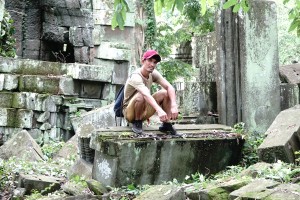 The other gibbon inside Preah Khan
The other gibbon inside Preah Khan
And that was the end of the adventure or so we thought but not quite as we still had fifty meters of flooded road to cross, South of Ta Siem, pulled by a kroyun for 15,000R (~$4).
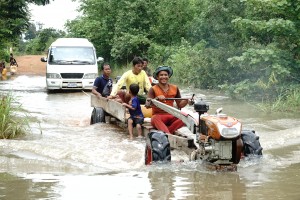 Just when we thought it was all over – heading South to Stoung
Just when we thought it was all over – heading South to Stoung
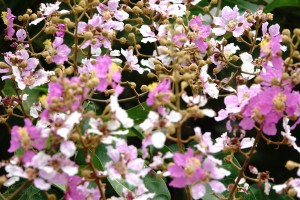 A flower to finish
A flower to finish
Indochine Exploration is pleased to partner with and support BeTreed www.betreed.com with mountain bike and hiking adventures. Please contact us at info@indochineex.com
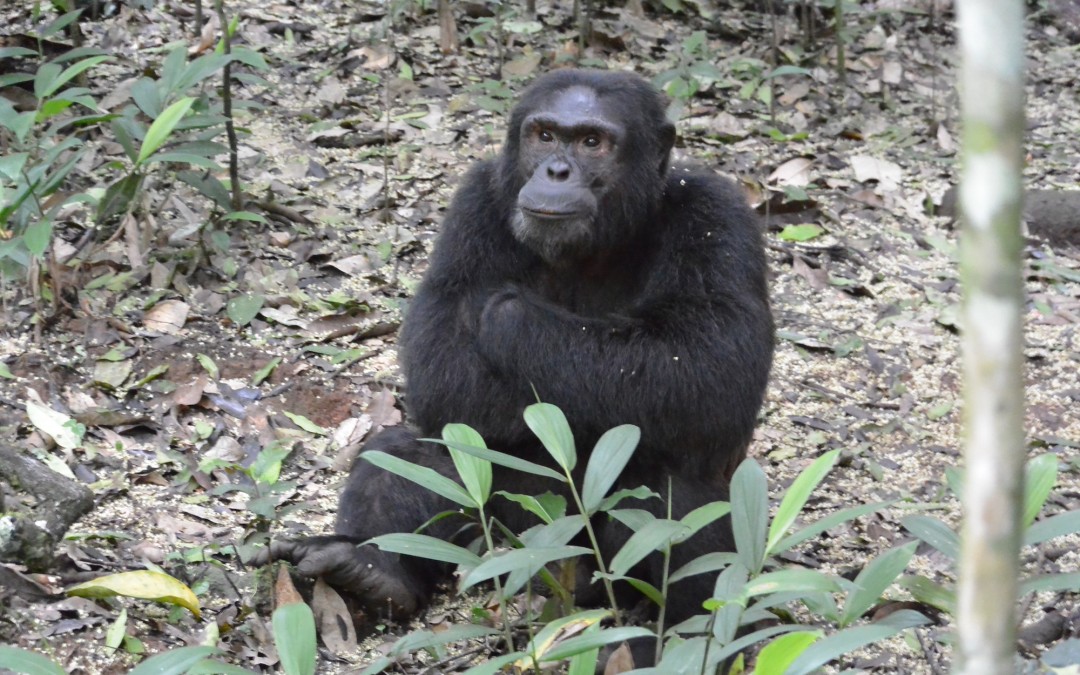
by Nick | Jul 15, 2018 | Blog, Conservation, Uncategorized
A Rwenzori Ramble
Uganda April 2018
Summary
Saturday 28th Depart London
Sunday 29th Arrive Nairobi and onward flight to Entebbe
Tuesday 1st May Fly to Kahihi and drive to The Ndali Lodge
Wednesday 2nd Chimp tracking Kibale Forest & Bird watching Bigodi Wetland
Thursday 3rd Morning drive to Kyambura Gorge Lodge and afternoon game drive in Queen Elizabeth National Park
Friday 4th Morning Chimp tracking in Kyambura Gorge and afternoon boat ride on Kazinga Channel
Saturday 5th Ishasha Forest game drive then transfer to Buhoma and Bwindi Lodge
Sunday 6th Walk to falls – birding in Bwindi Impenetrable Forest
Monday 7th Bird watching in Bwindi Impenetrable Forest
Tuesday 8th Drive to Kasese airstrip, flight to Entebbe then on to Nairobi
Wednesday 9th Nairobi – London
Friday 27th – Sunday 29th LHR 1755 KQ101 2J Arrive NRB 0430
‘You’re late,’ ‘No I’m not,’ ‘Laura said you’d be here at 4,’ Sally told me.
Since I’d orchestrated a hire car drop off, a Southern Rail journey – perhaps the most miraculous, lunch with Laura, an internet booked gym session then the tube to Charing Cross, I was a little affronted. Heyho it wasn’t finished yet, we had the Circle Line to navigate – destination the Barbican for Stravinski’s Right of Spring and followed by Rackmaninof.
The intelligent audience of nice looking people appeared to hear Stravinski as I might hear Hey Jude by The Beatles, I couldn’t translate. Rackmaninof was more approachable so when the pianists started shaking their shaggy heads and raising their hands above the keyboard I was with them.
As with Little Red Fox in Siem Reap for domestic adventures so it was with the Sky Team Lounge at T4 for the African adventure upon which I was about to embark “A Ramble in The Rwenzori”. I had been to see gorillas in Virunga last year (land of a thousand lakes – or was it hills – blog).
The supply of champagne was a touch on the parsimonious side and of course I got there too early but seat 2J wasn’t exactly slumming it. Willy Wonker and The Chocolate Factory was a moral tale with a gruesome ending for the revolting children or should have been except that Rohl Dahl and the directors took the soft option of having the horrible children and their ghastly parents resurrected. Of course Willy (not the wonker) wins because he’s modest, principled, polite and above all cute. The food was shit but better with Moses on the Embrauer to Entebbe and they had more champagne.
0655 KQ410 2A – ENT 0815, The Boma
 The Boma in Entebbe
The Boma in Entebbe
I have a dread fear of queues and forgot my hat. East African airports have lovely air-bridges but they don’t use them so when we had to squeeze on an airport bus all men are created equal and being last off the plane because I forgot my hat, meant the front of the queue for immigration. Oh God my yellow fever certificate – back of queue. ‘E-visas this line,’ front of queue, the immigration officer walks away – back of queue. It didn’t take long and my bag was off first.
The faded salmon pink Boma Birding Boutique as it should be known, was not too perfect and generally lovely.
There’s a lot of people in Uganda and even more birds. I haven’t really been trying but they keep sitting and singing in front of me. Hornbills, weaver-birds (little vandals shredding leaves). Bulbuls, thrushes and finchy things I didn’t spot for long enough to identify. Ibis stabbed at the lawn, pied crows called raucously, black carrion kites soared. And then there was the Botanical Gardens beside the sea, well Lake Victoria but as good as. Egrets, cormorants, darters, pied kingfishers hunted along the waterline and rubbish birds or Maribou Storks scavenged in the park (adjutants in Cambodia).
Sweet Heart Coffee in the Victoria Mall – it reminded me of my early Cambodian assignations with Catrina on our escapes to Phnom Penh. I had a double latte, perfect timing as my legs felt like lead. It even has a gym – it will be part of the cultural experience to try it out.
Monday 30th
I’m not going at 7am! They haven’t bothered to find out where I am so I stamped my feet and spat the trolley out with the pram. Actually it’s mainly because I like Entebbe and wouldn’t mind staying longer.
 Hadada Ibis on the shores of Lake Victoria
Hadada Ibis on the shores of Lake Victoria
An alarm bird, Fred told me is the local name for the weavers, penetrated my Valium induced coma briefly then I fell asleep again until my phone started ringing from somewhere under the bed sheets. I fumbled my way into consciousness slightly resentful of waking up until I realized I’d been asleep for ten hours and should feel good so I did.
It was bugging me. It sounded a bit like a hornbill, that sort of size but the beak was too small. It looked like a thickset magpie but according to my book, which is pretty thick, there aren’t any. I’d seen it eat fruit so the beak wasn’t a raptor’s, a coucal? nearly, an Eastern-grey Plantain Eater. The other species that had been bugging me was the brilliant crimson chested Black-headed Gonolek but it’s about the shape not the colour.
Prior to sweet heart coffee I’d noticed a gym. Two nights with little sleep, a nine hour alcohol fuelled flight/s then a long stroll round Entebbe meant it didn’t appeal yesterday but today was different.
Cameron was a UN helicopter pilot working in Southern Sudan and staying at the Boma. He drops food parcels on people’s heads if the isn’t planned well. There’s some big UN aircraft on the apron at the airport. He’d worked in PNG so lunch went quick such that I was late for Fred my bicycle guide.
Right said Fred – I had to get that in, ‘we’re going to cycle to the reptile farm, visit a homestay, the local town center, the ferry then back to the guesthouse.’ Fred’s 22, studying accountancy, works freelance for Bike2go and has no money as he kept, I’m sure truthfully reminding me. He’s lean, good looking and doesn’t smell much.
Fred told me about the church and the Chams – Muslims. He didn’t tell me about the government, which told me more though others later in the adventure did. His life, he’d split up from his girlfriend but had a ‘target’ in site. Dating, sex, marriage all ok but not to be gay.
Simon showed us round the SNCC a snake farm. It wasn’t a farm but a conservation project. Simon cared for his snakes and animals. He gave the tortoises calcium shots to help them repair their shells. As usual the snakes are an easy scapegoat and get beaten to death if caught unless the conservation message has got through, are still alive and somebody can be bothered to bring them to the conservation center. ‘The first bite they don’t inject venom, so its only when they keep getting abused that people get poisoned’ said Simon.
 Tortoise with damaged shell at SNCC (+ me)
Tortoise with damaged shell at SNCC (+ me)
The SNCC abutted the massive marsh I’d seen from the air. Simon told me it was inhabited by otters, duiker, snakes, etc but now could be reclaimed. Like the Botanic Gardens, where I could see the chunks that had been munched out for development.
Lake Victoria is vast. Arguably the largest lake in the world, of course the Americans claim that Lake Superior is bigger but Fred thinks they didn’t measure it properly.
Actually it wasn’t Fred. ‘Do you mind if I answer the question?’ A polite bystander enquired, compare that to Cambodia where a conversation is common property. ‘Where is Lake Victoria?’ I asked, which seemed like a stupid question as Entebbe is surrounded by it. He pointed in the direction of some storks (black open-bill) and pelicans to where a speedboat was heading out on the nine hour journey to Tanzania.
 Chameleon on Fred’s arm
Chameleon on Fred’s arm
Tuesday 1st May ENT 1245 – Kahihi 1435, Ndali Lodge
Whisky in the tea hadn’t been a good idea, nice at the time but the next morning not so good as I contemplated the idea of getting up. ‘Was breakfast nice?’ Not very, I thought but said ‘alright thanks,’ which resulted in an awkward silence. Bugger the rain, I said to myself and got on a boda-boda back to the gym in Victoria Mall under an innovative umbrella that was positioned such that the motorbike taxi didn’t turn over at 40km.
The baby out with the bathwater had worked. George or Simon dropped me off at the airport. I wandered vaguely in the direction of where I thought the airplanes should be and met a lady who took me to meet a menacing security guard who sniffed my bag.
 Simon flying us to Kahihi
Simon flying us to Kahihi
Next stop a less menacing security man who wasn’t worried about my shoes, watch or belt. The lady said goodbye and George or Simon took me to a little bus, which sped across the Tarmac to my own Cessna Caravan where I met Simon and George who were going to fly the three of us to Kahihi.
It was a stunning flight. At 5000ft we flew under the clouds and dodged the weather systems I could see on the radar in front of me. Lake Victoria to the left and guess what Lake George ahead. A few buffets, a right turn for the final approach, a bumpy landing on the grass strip then we taxied to the little hut where I was laboriously but politely registered. Reassuringly a Volcano Safari’s Landrover was parked with Francis my driver and guide waiting. He appeared a clone of Robert the Rwandan guide last year. At least Francis knew his birds.
 The landing strip at Kahihi
The landing strip at Kahihi
‘Why’s Ndali special?’ I asked Robert, I mean Francis. Special its jaw dropping! Aubrey and his clan own a thousand acres around a crater lake with views from the lodge to villages lining the rim and the lush mat of indigenous trees gripping the soil together on the steep hillsides. Looming above us to the West were The Rwenzori or Mountains of the Moon rising to over 5000m. So called because the early colonialists thought they were tall enough to touch the moon.
 Ndali Lodge
Ndali Lodge
About my own age the couple on the table at lunch had been in Uganda for thirty years and had a farm also a house in Kilkenny. They’d come to Ndali to talk with Aubrey the owner about growing vanilla. ‘Who was he?’ I asked Simon the GM. ‘Dr Ian he has a hospital.’ Later I learnt he was Ian Black a Ugandan citizen, newspaper columnist and former Mayor of Kampala.
At breakfast that morning I’d met a lady who’s husband protects a national park in the DRC the size of Wales (they’re always the size of Wales), home to 47 giraffe at risk from Sudanese poachers who shoot them for their tails to be used as flywhisks. They also prevent the poaching of 1300 elephants.
 Crater lake to the East
Crater lake to the East
‘Three hours to walk round the lake,’ said Francis but Simon (maybe George) and I took one hour.
My own plane, my own lodge – there’s no one else staying here, a candelabra with flickering candles on the table, William the barman and Grace the waitress. An overload of experience which is more than I can process tonight.
 Holub’s Golden Weaver – seen walking around the crater lakes
Holub’s Golden Weaver – seen walking around the crater lakes
Wednesday 2nd Chimp tracking in Kibale Forest & bird watching in the Bigodi Wetland
I eyeballed two species of monkey today. First Totti who wasn’t giving anything away and stared back with distant black eyes, then a Red Colobus looking at me from a branch above. Human like but at the same time unsettlingly alien. Endemic to Uganda they like rotten fruit, which ferments in their stomachs. They get drunk and pick a fight with the chimpanzees who eat them. The chimps were the main attraction but more on them in a minute.
 Crater lake to the West
Crater lake to the West
The clocks are about an hour out in Uganda, great because I’m still writing this outside at 7pm when the equator is just a 100km to the South. It does mean that the wakeup tea was delivered in pitch darkness and breakfast taken with the East door open to let in the light. My table was positioned to watch the sunrise but it was late this morning and Francis and I were on the road before the sun was up.
Subsistence agriculture shapes a diverse landscape. A patchwork of small fields surrounded by useful trees and shrubs. It’s not quite as intense as Rwanda but most contours are farmed. Cambodia the land where the bong thoms* roam is increasingly agri-industrialised leading to endless horizons of uniformity. The pockets of subsistence farming left are picturesque but it wasn’t a one sided story. There were ring barked trees and the intensity of agriculture and diversity of landscape could only happen because of the soils fertility.
*kindly described as influential politicians and business people
Kibale Forest; mysterious, magical and full of fantastic life. An African-grey Parrot flew in front of the Landrover. We stopped to watch Olive Baboons. There’s thirteen species of primate marooned in this enclave of biodiversity previously connected with the great jungles of The Congo.
We had to walk. Francis told me it was a short distance but three hours later we were still going. Bosco our guide who identified birds from calls I didn’t even hear (assuming he wasn’t making it up) and another couple from Chile. The first sign of a chimpanzee was a mound of poo, ‘they’ve got diarrhea.’ ‘It’s a Scaly-breasted Eradopsis,’ Bosco said. ‘Is it painful?’ Finally black bundles in the treetops then a crash as one descended and ran along the path where I was standing. Totti the alpha male 55 kg of muscle chasing Tifu, his ‘target’.
 Totti, the alpha male
Totti, the alpha male
We followed fast behind attempting to snatch a photo on the run, ‘keep going until they sit,’ said Bosco so we ran until Totti sat. The violence and drama temporarily dispelled as he sat in quiet contemplation while I anthropomorphized, looking in his black eyes and wondering what he was thinking about. Gorilla like he lay stretched out and scratched his balls (photo below).

Nelson in The Bigodi Wetlands also knew what he was talking about. Within 500m we had ten new species of birds. Bigodi was swamp forest surrounded by maize, tobacco, coffee and cabbages. ‘Does eco-tourism make a difference?’ I meant that with the intensity of the surrounding agriculture does it help to relieve pressure on the small reserve. He said it did. It’s all green but on our left Bigodi and an incredible array of shape and form and on the other a monochromatic uniformity.
 The Bigodi wetlands
The Bigodi wetlands
So many birds but the monkeys were lacking save for some shaking branches. We followed a track into the swamp to see trees festooned with Red Colobus, closely followed by a Grey-cheeked Mangabe. There were Black and White Colobus in the trees at the edge of the farmland, plus the Olive Baboon, Red-tailed Monkey and Chimpanzees we’d seen earlier meant six species of primate today. FYI colobus means missing which makes sense as colobus monkeys only have four fingers with no opposing thumb.


African Open-bill Stork & Black & White Colobus
Thursday 3rd am Transfer to Kyambura Gorge Lodge. pm game drive in Queen Elizabeth National Park
I didn’t think I’d slept well but surfaced from a full-on dream as Nelson knocked with morning tea. Not cold but nice under the covers, I watched the mountains turn a dusty pink. Suzu was lying by my bed, she’d been there all night. A friendly, rangy hound, her sister was outside.
Sleep assumes an even more important role than normal on a holiday like this because of the difference between being able to ride on the wonder of what you see or just being overwhelmed.
 Queen Elizabeth National Park from my banda at Kyambura Lodge
Queen Elizabeth National Park from my banda at Kyambura Lodge
It was downhill all the way as we descended from Ndale back past Kahihi and the strip where we’d landed all those hours ago, crossed the equator, we’re now in the Southern Hemisphere, and entered the Queen Elizabeth National Park (QENP). I thought Francis was joking when he said hippo but sure enough in a wallow beside the road a muddy mound with two eyes stared back. We spotted Kob antelope in the distance, the Ugandan national animal.
Statistics; its 2000 km2 though seemed bigger when we were driving to Bwindi. There are 2000 hippos that weigh up to three tonnes, 140 lions (out of only 400 in the country), leopards, hyenas, chimps, 400 species of birds, etc. and the lodge. I have to pinch myself, first the West and now the East side of the Great African Rift Valley.
My banda is called Brutus and looks out over half of Africa. Et tu Brute, probably a knife in the back from the dance troupe stamping a war dance in reception (a sort of African version of morris dancing) but OTT after the drive.
 Elephant below the lodge
Elephant below the lodge
It’s becoming a spoilt boys obsession to avoid being over pampered or overfed. ‘You only want that?’ like I’d committed a cardinal sin at breakfast when I only ate muesli. My new butler – yes get that, at The Kyambura Lodge wants me to eat and drink so that she’s got something to do. Instead its becoming a mission to avoid Peace – is there something profound here, that’s her name! So looking right and left I furtively closed the door to my banda, and took a small path so I could run undetected.
It seems right is right in Africa, usually I go left but this time right up the hill past a lot of children shouting mzunga, that’s me. Near the top I looked down to two crater lakes and gratifyingly my track connected with the road we’d come on so it was a circular run and right was right.
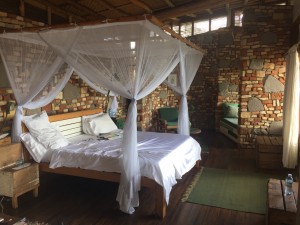 My banda
My banda
Friday 4th am Chimp tracking in Kyambura Gorge. pm Kazinga Channel wildlife from boat
The QENP a vast grassy expanse roamed by elephant bisected and by a slash through the middle bursting with life, The Kyambura Gorge is as unexpected as its magical. One of the most beautiful places I have ever seen.
 The Kyambura Gorge
The Kyambura Gorge
Lazarus or Edward led us with the obligatory gun down a muddy path that descended to a fast flowing brown river. The canopy now high above us enclosed a prime-evil world of snorting hippos and screaming chimps.
The foliage was so thick that we meandered beneath the canopy between tree trunks and hanging vines waiting for our eyes to become accustomed to the gloom.
A few minutes later we saw our first black bundles. The dominant male ran down the tree like it was an airport travelator. He beat the buttress of the trunk like a jungle drum, barred his teeth and screamed violently.
Another male in a distant part of the forest screamed back. Dominance asserted our male lay on the floor, crossed his legs and contemplated the sky.
This time I could see the colour of his eyes, brown in an expressionless face. ‘Do they show emotion?’ I asked Edward. ‘Yes, anger, excitement, pleasure.’
The big male was part of a group that hung around this part of the forest where fruiting fig trees grew. A primates paradise that other chimpanzee groups would like but human encroachment had cut them off resulting in an isolated gene pool. ‘We want to open a genetic corridor with fig trees up and down the gorge connecting the populations.’


 Left and above the Kyambura Gorge Troup
Left and above the Kyambura Gorge Troup
I hadn’t slept well for worrying about unraveling relationships then ‘Good morning, good morning,’ Peace was singing as she bought my morning tea. ‘Oh shut up.’
A Mexican family were staying at the lodge, they’re tour operators, went to Pure in 2017, had an appointment with Smiling Albino and I recognized the two sisters.
Francis’s Landrover, technically mine for the week had broken down, so I went with the Mexicans to the Kazinga Channel. A forty kilometer stretch of water connecting Lake George with Lake Albert, surrounded by the Queen Elizabeth National Park (you’d never know the British had something to do with it).
 The restaurant terrace at the lodge
The restaurant terrace at the lodge
The countryside was dominated by candelabra cactus, invasive aliens that were being knocked down at one site by a CAT. The elephants do it for fun.
The metal tourist boat was a bit of a let down after all the personal pampering but the bird life was prolific. James this time, helped me to identify twenty seven species but it wasn’t just the birds …..


Hippo and Water Buffalo (with Oxpeckers) in the Kazinga Channel
The Yellow-billed Oxpickers were busy stabbing ticks on the back of submerged water buffalo. Massive swirls appeared beside the boat followed by the great grey bulk of hippos, showing off their impressive dental kit and beady, angry eyes.


Residents of the Kazinga Channel, Elephant & African Fish Eagle
A small group of elephant scratched against a Mopani tree and a crocodile tossed a thrashing tilapia in its jaws then swallowed it whole. Warthogs knelt down to graze ‘because they’ve got weak necks,’ James said. Pied Kingfishers were perched on every vantage point and flying into holes in muddy cliffs along the shoreline. They dig to escape the monitor lizards, or it could be the monitor lizards dig holes to catch the Pied Kingfishers. On cue the culprit appeared, a meter long lizard.
At the confluence of the channel and the lake a sandy beach was crowded with plovers, geese, gulls, cormorants, pelicans, Ibis and a dainty hippo grabbing a quick graze before sinking into the support of the soothing water.
A park boundary defined fishing village, allowed because it was there before the park was gazetted, lined a low ridge. My gaze moved to where three young men stood washing themselves in the water. I looked again and saw they were naked, washing each other and er well endowed. ‘Hmm’ I thought, Central Africa’s not totally un-homoerotic.
 Young hippo and water birds along the channel
Young hippo and water birds along the channel
Saturday 5th Ishasha Forest game drive and transfer to Buhoma and Bwindi Lodge
The pastel colours of the park changed. The gorgeous surreal suggestion became reality as I contentedly gazed from the comfort of my large bed sipping Peace’s tea (it was a teabag not proper tea!).
 The Ishasha Forest (there were some more trees)
The Ishasha Forest (there were some more trees)
Driving South for five and a half hours, most of it through the QENP. A vast expanse of empty space with few people, bordered by Lake Edward and the Virunga Mountains, beyond the mysterious and brooding Congo. ‘If Mr Praveen (the owner of Volcano Safaris) opens a lodge I’ll go there,’ I told Francis. Meanwhile UK tourists to the DRC Virunga Park were being kidnapped and ebola’s broken out, I later learnt.
It’s a bird watchers paradise, nearly 400 species in the QENP alone. I’ll list the birds and animals I’ve seen in an appendix to the blog. Vervet monkeys peered out from the undergrowth. The trees were festooned with Black & White Colobus and Olive Baboons roamed the roads.
Hammerkops are undistinguished birds with bad hair. They make up for it by building enormous nests. It’s an obsession.
The tree-climbing lions of Ishasha were out to lunch. They certainly weren’t on any of the horizontal fig tree branches, their usual daytime hangout, that we searched for across the plains in our long wheel based Landrover. We had a picnic beside the Ishasha River joined by snorting hippos then set off for Bwindi, narrowly avoiding mating Kobs. ‘I don’t need Kob porn,’ I told Francis so we left the grassland tracks for the main – dirt – road. And returned to world of humans separated from that of animals by a two meter deep trench.
In the rising mist Bwindi lives up to its name and looks impenetrable. I’m in Bob’s bungalow, that’s the name of the room, looking across the valley at a wall of green as the forest climbs the steep hillside broken only by the trunks of the tallest trees. Gorillas were here this morning. I’ll put out a glass of Sauvingnon in the hope they return. The colobus were content with fermenting fruit and picking fights with the chimps.
Sunday 6th Walk to falls – birding in Bwindi Impenetrable Forest
The breakfast room at the lodge butts out over lawns carved from the forest at the edge of the national park. The staff seemed particularly excited about something then Adolf beckoned me to follow with a conspiratorial smile. A family of gorillas were having breakfast, eating the vegetation in a clearing below the lodge. Transfixed and awestruck I stayed until a park ranger appeared shoeing me away – I didn’t have a $600 pass.
Tropical rainforest with a thirty-meter high canopy, towering giants clad in shrouds of moss and lichen, shafts of sunlight illuminating the delicate fronds of ferns. We followed the lively Munyanga Stream upstream. The lit translation is the grabber. It washes away and grabs the crops along its banks as it flows down to a river.
The source is a spring thirty kilometers up the valley but still inside the park, hence the clarity of the water.
Villagers strolled up and down the path but still we needed two armed guards, no doubt in case of racist elephants. O’Max my guide tried to sell me hiking and tour arrangement in Uganda when I told him I ran a tour company, which has a serious appeal, excepting the gay issue.
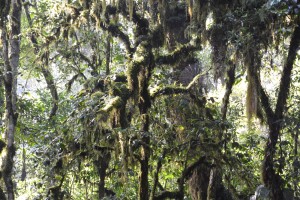 The impenetrable forest
The impenetrable forest
 The Munyanga Stream
The Munyanga Stream
An enchanted path loops below the lodge, down to the river where a trickle of crystal clear water flowed. A bronze coloured duiker (Black Throated) didn’t hear me long enough for me to catch a glimpse. I seem to keep finding naked Africans, men, that is and well endowed. I suppose its because in general the women are large and the men small so they need a large cock to bridge the gap.
‘Pick’ said Fred so Anus and Dorythea decimated a tea bush plucking the top two leaves and central bud as Fred kept reminding Adolf and I, though I don’t suppose Adolf needed reminding as being a butler, mine I later found out, he’d heard it before. The bits of bush were tossed into a basket with large holes so consequently fell out. At a small hut Fred told Anus to use his pestle and grind the leaves to a mush. ‘Fire’ said Fred so Dorythea heated the mush until it was dry. ‘Sieve’ said Fred so Anus sieved it until something approaching tea was collected. Green tea is steamed and not fired. ‘Drink’ said Fred, sorry I mean would you like a cup of tea? ‘Yes please, black,’ it seemed appropriate and was very good.
Adolf made me wake up tea the next morning, ‘where’s the milk?’ ‘Innit,’ said Adolf. It was African tea, ginger, bay leaves, cinnamon and milk, which after I’d got over the surprise was delicious.
Monday 7th Bird watching in Bwindi Impenetrable Forest – day 2
We walked to the border of the park and the DRC, twenty-six kilometers. ‘It’s a long walk,’ said Francis but he hadn’t mentioned 26k. ‘Hmm,’ I thought as he introduced me to Nicholas.
The forest trail is a local highway but we had to have the obligatory two guards and AK47’s. The obligatory two guards realising we were walking to the other side of the park bailed out and had to be replaced.


Flycatcher (above) and sunbird right
Francis had oversold me to Nicholas who thought I was a hard-core fanatic and let loose with his twitching tendencies. Little brown jobs silhouetted in the gloom is not really my kind of bird watching. ‘Its an immature Black Bee Eater,’ said Nicholas as he pointed with his green light saber. ‘The only thing we can agree on is its black and barely indistinguishable from the leaf it’s sitting on,’ I thought.
It started to rain ending any pretensions of bird watching for me, ‘its only another hour,’ said Nicholas. ‘Another hour to what?’ ‘Till we get there,’ ‘what happens then?’ ‘We come back.’ The logic inescapable, the appeal not great but we’d come this far.
The end of the trail was a suspension bridge over the River Ivy. It was like walking on ice unexpectedly so my feet disappeared from under me and slid over the side, luckily I managed to grab onto the bridge. On the other side of the river a grassy valley and a lot of birds having a break from the impenetrable forest.
The biodiversity is phenomenal, apart from the headline species; gorillas, chimps, elephants, colobus monkeys, there’s thirty odd species of endemic birds, some critically endangered of which I saw three. Forty species of endemic butterfly and maybe mammals, Nicholas wasn’t sure. An ancient island cut off from the once vast and still pretty big forests that extended across central Africa and covered all of Congo.
My barely functioning legs felt like lumps of lead as I limped out of the park entrance and made straight to the Bwindi Bar. A couple of Nile Specials and humanity returned.
Four dusky slate blue warblers sat under a yellow flower fluffing up their feathers and preening. Bulbuls hoovered up insects as they rose from the sodden vegetation and the dense forest disappeared as cloud advanced up the valley. Dusk was giving way to night as I wandered my weary way to dinner.
It all started with Rackmaninof & Stravinski, it’s not quite finished yet, where will it end ……….., read on.
Tuesday 8th & Wednesday 9th return Transfer to Kasese 0945 – ENT 1125. ENT 1720 – NRB 1830 KQ415 2A, The Lazizi Premiere NRB 0920 – LHR 1615 KQ100 2A
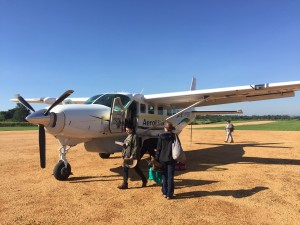 Boarding our Caravan at Kasese with Noemi, the Mexican tour operator
Boarding our Caravan at Kasese with Noemi, the Mexican tour operator
I had a dream, which meant I slept well. Unusually I could remember a little bit, about going into a suspended animation and just as I was about to wake up Adolf woke me with his African tea. It was still black at 6 but a glimmer of light penetrated a quarter of an hour later and by 6.45 I could see the valley.
The weaver-birds are bit like the hammerkops in that they’re obsessed with their nests and fly backwards and forwards carrying tails of grass adding to its construction.
The light was sparkling in the damp from yesterday’s rain, the valley bottom filled with mist and now sunshine bathing the hills on either side. I didn’t want to go. Even Francis and I had become buddies.
The Cessna Caravan landed shortly after we arrived at the Kahihi airstrip and we squeezed in with some Americans, flying back the journey we’d driven down. Over the Ishasha Forest, the plains of the QENP, the Kazinga Channel with the Kyambura Gorge in the distance. Even over the London Bridge imported for the Queen when she opened the Park. Lake George on one side and the Rwenzori on the other as we took off for Entebbe. A full hours flight despite my thinking it couldn’t be much more than a three hour drive. I would have been enjoyable except I needed a piss – badly by the time we got there.
I found a taxi at Entebbe who over-charged me but not badly after we’d bargained a bit, got to the Boma. I had three hours so got changed picked up a boda-boda, went to the Victoria Mall gym for an hour. Had a chilled lunch and spotted yet another species of bird. ‘We’re vegan would you like our garlic bread?’ ‘Of course you are,’ I thought. An American mother and son – or toy boy (I don’t think she was that interesting) asked. I bought a book on mammals at Entebbe airport and watched an enormous Emirates 777 take off.
Totally unnecessary but rather fun, I was the only one at the front of the plane with a glass of champagne safely installed beside my seat. It was like the good old days on the way to Frankfurt when I managed to get in five little bottles of Piper Heidsick before touch down.
It was fitting that the Crowne Plaza at Nairobi Airport was horrible on the last night. I had a burger without the bun, in a bland eating space watching a screen repeat the benefits of the bland hotel. The contrast with exciting lodges on the edge of the wild was absolute.
Work invaded; Tigers pissed off Christian, who knows if we’ve got the JPA school on a BeTreed trip. What Buntha and the rest of the Chheangs are doing is questionable, Manus sent me a nasty message and Own is ill.
And one more species, we’d seen the Crested Crane on the way to Bwindi and a Wooly-necked stork on the way back. A magical place set in a magical country.
Appendix 1. Bird List
Boma
- Hadada Ibis
- Ring-necked Dove
- Eastern Grey Plantain Eater
- Common Bulbul
- African Thrush
- Red-chested Sunbird
- Black-headed Gonolek
- Black-headed Weaver
- Ruppells Long-tailed Starling
- White-browed Robin Chat
Entebbe
- Great White Pelican
- African Open-billed Stork
- Cattle Egret
- Little Egret
- Maribou Stork
- Pied Kingfisher
- Black Kite
- Pied Crow
Kasese
- Black-headed Heron
- Grey-backed Fiscal
- Laughing Dove
Ndali
- Pink-backed Heron
- Cinnamon-chested Bee-eater
- Common Waxbill
- Grey-headed Sparrow
- Ross’s Turaco
- Great-blue Turaco
- Crowned Hornbill
- Pied Wagtail
- Red-billed Firefinch
- African Harrier Hawk
- Holub’s Golden Weaver
Kibale Forest
- Grey Parrot
Bigodi Wetlands
- Black and White Casqued Hornbill
- Copper Sunbird
- Splendid Starling
- Purple-headed Starling
- Woodland Kingfisher
- African Pygmy Kingfisher
- Pin-tailed Whydah
- Black and White Mannikin
- African Blue Flycatcher
- Black and White Shrike Flycatcher
- Bocages Bush-shrike
- Red-headed Malimbe
- Speckled Tinkerbird
- Yellow White-eye
- White-chinned Prinia
- Little Greenbul
- Western Nicator
- Southern-red Bishop
- Tambourine Dove
On route to QENP
- Lizard Buzzard
- Red-eyed Dove
- Yellow-billed Kite
- Long-crested Eagle
- Speckled Mousebird
Kyambura
- African White-backed Vulture
- Vieilott’s Weaver
- Yellow-fronted Canary
- Bronze Sunbird
- Northern-black Flycatcher
- White-headed Saw-wing
- Common Scimitar-bill
- Yellow-chested Sunbird
- White-browed Coucal
- Lesser-striped Swallow
The Gorge
- Grey-headed Kingfisher
- Common Buzzard
- Ring-necked Francolin
Kazinga Channel
- Egyptian / Nile Goose
- Yellow-billed Stork
- Grey Heron
- Spar-winged Lapwing
- Hammerkop
- White-winged Tern
- Yellow-billed Oxpicker
- Black-winged Stilt
- Common Greenshank
- African Skimmer
- Water Thick-knee
- Sacred Ibis
- African Fish-eagle
- Palm-nut Vulture
- Black Crake
- African Jacana
- Yelloueenw-backed Weaver
- Red-throated Bee-eater
- African-wattled Lapwing
- Great-white Egret
- Red Cormorant
- Great Cormorant
- Gull-billed Tern
- Lesser Black-backed Gull
- Grey-headed Gull
QENP
- Helmeted Frankolin
- Red-necked Spur Fowl
- Fork-tailed Drongo
- Arrow-mapped Babbler
- Yellow-throated Long Claw
- Blue-naped Mousebird
- Fan-tailed Widow Bird
- Grey Kestrel
- African Green Pigeon
- Sooty Chat
- Red-rumped Swallow
- Martial Eagle
- Bateleur
- Madagascar Bee-eater
- Flappet Lark
- White Stork
- Rufous-necked Lark
- African Fire-finch
- Grassland Pippit
- Common Sandpiper
- African Grey Hornbill
- Black & White Cuckoo
Around Bwindi
- Auger Buzzard
- Grey Crowned Crane
- Wooly-necked Stork
Bwindi Impenetrable Forest
- Short-tailed Warble (an endemic species and critically endangered not see but heard)
- Mountain Wagtail
- Blue-headed Sunbird (endemic)
- White-tailed Crested Flycatcher
- Yellow-rumped Tinkerbird
- African Blue Flycatcher
- Tiny Sunbird
- African Paradise Flycatcher
- Northern Double Collared Sunbird
- Grey-headed Sunbird
- Olive Sunbird
- Bar-tailed Trogon
- Elliot’s Woodpecker
- Brown-capped Weaver
- Black-crowned Waxbill
- Yellow-fronted Tinkerbird
- Grey-throated Barbet
- Mountain Illadopsis
- White-tailed Ant Thrush
- Equitorial Akalat
- Red-faced Warbler (endemic)
- Olive-green Caneroptera
- Red-tailed Bulbul
- Dusky-blue Flycatcher
Appendix 2. Mammal List
Kibali Forest
- Common Chimpanzee (and Kyambura Gorge)
- Central African Red Colobus
- Olive Baboon (and throughout trip)
- Grey-cheeked Mangabe
- Vervet Monkey (and Bwindi)
- Red-tailed Monkey (and throughout trip)
Bigodi Wetland
- Black & White Colobus (and Bwindi)
QENP
- Ugandan Kob
- Bush Elephant (also Kazinga Channel)
Kazinga Channel
- Common Warthog (and Ishasha Forest)
- Common Hippopotamus (and QENP)
- Cape Buffalo
Bwindi
- L’Hoest’s Monkey
- Mountain Gorilla
- Black-fronted Duiker
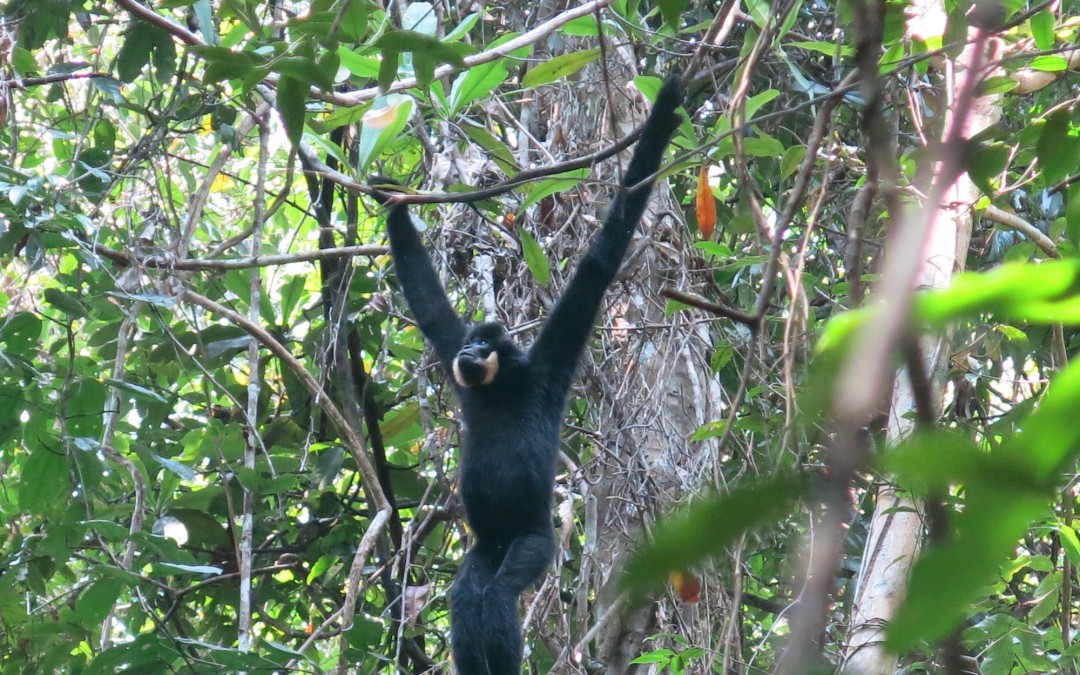
by Nick | Dec 10, 2017 | Blog, Conservation, Hike
An Audience with a Northern Buff Cheeked Crested Gibbon
Etiquette is important in the ape world, or are they monkeys? It all depends on how long the arms are – long, so apes like us, which makes us relatives and our meeting a family call.
We invited the Northern …. Lets say NBCCG’s to visit us in Siem Reap and in days gone by when the North of Cambodia was covered in forest, they would have obliged and swung their way across the country, the slight issue of the Mekong River aside. The patches of trees left are barely enough to sustain a soaring stork so we were on our way via said Mekong to The Terres Rouge Lodge in Banlung.
 Male Northern Buff Cheeked Crested Gibbon (NBCCG)
Male Northern Buff Cheeked Crested Gibbon (NBCCG)
We being Jady & I accompanied by Naven from Conservation International and driven by Dy. He’s nearly one of the family now as he’s courting a Chheang, Sreymom, who excepting me pretty much run ICE. It’s a straight forward seven hour journey heading East towards Vietnam on new roads. The orgy of logging is desperate but that’s Cambodia for you.
We opened the car doors to delicious cool and colonial charm of The Terres Rouge Lodge beside Banlung Lake.
Jammy from Red Parrot tours was waiting at his restaurant The Green Carrot. It might have been the other way round. A true entrepreneur he was advertising the unique selling point of his company, which was apparently a free toilet. He’d made a laminate sheet with an explicit cartoon of a man doing his business under a double decker bus.
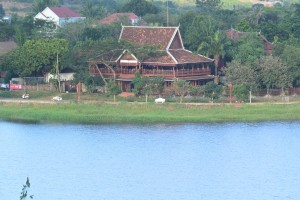 The Terres Rouge Lodge in the old Governors building
The Terres Rouge Lodge in the old Governors building
There was an adventure to be planned over the red wine and fish oops beer and chicken, a boat up the Sesan River and a trek to a waterfall, an indigenous cemetery then a motorbike ride to the edge of our cousins territory.
The morning light over the lake was a delight as we drank our Khmer coffee and waited for Naven. A smooth red earth road headed North as it descended into the Sesan floodplain and Kchang village where Sresh our boatman and guide for the day’s adventure was waiting for us.
We brushed aside some confusion as to what we were doing, with what and who and boarded Sresh’s narrow wooden long tail. A step up from the usual Sesan river craft as we sat on a dry mat not in the customary half inch of sludge.
Blurred blue hills fringed the horizon as we sped upstream past clumps of stilted houses nestling under shade trees. Ferry’s traversed the river while the inevitable sound of chainsaws reverberated across the water.
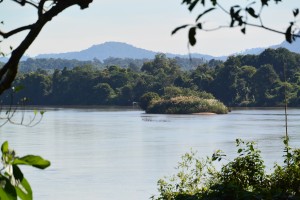 The Sesan River
The Sesan River
Our boatman was emerging as Sresh our guide. Clad in not much more than rags hanging off his skinny frame, we found that he’d taught himself rudimentary English when he answered our questions in a gentle toned timbre.
Note; The day’s adventure was an adjunct to our appointment with the cousins as they were busy entertaining Lucky Carrot guests today.
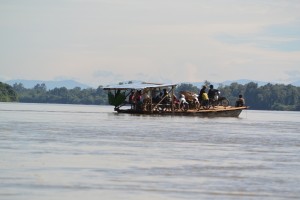 Ferry across The Sesan
Ferry across The Sesan
Sresh strode ahead in Wellington boots and ripped tracksuit bottoms. Jady and Naven reminisced on the biodiversity workshops they’d attended, while I hobbled behind on a dodgy hip. A cashew nut grove, a cow field then into the open dry deciduous forest with a picture post card view of a village spied through the trees. Bright green paddy fields surrounded thatched roof huts.
We wound our way up a rocky path and spotted a lump of dried turd. ‘Hmm?’ Said Jady, and ‘take a photo,’ ‘a new species?’ Perhaps a serow we mused. ‘Another photo,’ Jady pointed to an orchid implanted on a tree trunk. Our route descended into a riparian forest of bamboo. Sresh hacked at a stem and fashioned a cup, which he gave to me. I was a little crestfallen when the others got one too.
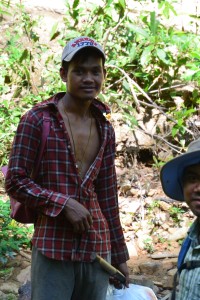 Sresh (below) and an orchid (above)
Sresh (below) and an orchid (above)
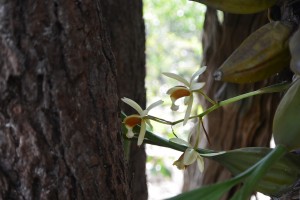
A beautiful walk beside a stream to where a waterfall fell out of the forest a level above. Cascades of spume enshrined the rock face and fell into an oval pool. We needed no invitation to plunge into the cool clear water. Draping ourselves over the warm black rocks, contentedly munching ham and baguettes while staring at the hypnotic diamond droplets of exploding water.
Back on board Sresh’s long tail our next stop was a gloomy tribal graveyard shaded by tall trees. Huts adorned with brightly painted 2D ships for the journey ahead or the one past. A man with shades and woman with boobs stood guard to keep an eye on an electric fan in case it got hot. Empty beer cans, you can get 50 Riel for the aluminum and mummified rice, which lasts forever.
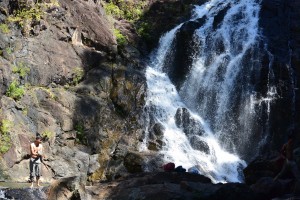 Koh Peap Waterfall (above) and village cemetery (right)
Koh Peap Waterfall (above) and village cemetery (right)
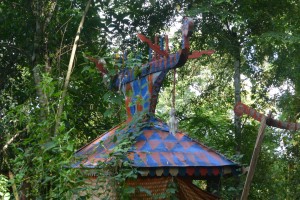
The English speaking guides (that didn’t) including the handsome Noi were waiting for us at Veunsai to take us to the CI Station. Jady and I would have probably preferred to go back to The Banlung Lodge but we had an appointment to keep so we duly sat aside the beaten up old bikes, dangled our legs as there were no foot rests and squeezed the driver in my case Noi, with my thighs.
An earthmover had cleared the way and bulldozed the trees a year before which meant the road was deeply rutted and bereft of shade but interesting enough. At ITub Village we turned off to cross a marsh leaving us wading through the wetland to rejoin our bikes before the forest. Chamkar or slash and burn agriculture aside the trees became taller and our route easier under the canopy.
A crude wooden bridge crossed the river beside the station and on the other side a fenced compound of tall timbered buildings where we’d stay the night. A pleasant evening with Jady and cold beer, chatting with Noi the handsome (did I say that before) English speaking guide who tried but didn’t. There was a fan in my room until 9 when the generator was turned off but rain had cooled the evening and it felt good to be in the middle of the forest sipping whisky and listening to In The Psychiatrists Chair in the dark.
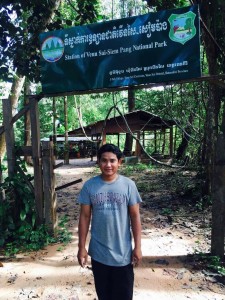 Conservation International Station at Veun Sai Siem Pang
Conservation International Station at Veun Sai Siem Pang
6 hours later I was fumbling in the dark to find my phone and a light. I stumbled to the deserted kitchen shack and managed to light the gas for a cup of tea. Growled at Naven coz no one was awake then hobbled off through the mud in the pitch black following a ranger who seemed unaware I was there.
Note that although priority No 1 was to meet the family we’d also hope that the process of getting there would be up to the Albino standard, it wasn’t.
Grumpy by default at 5am in the morning I blundered on behind. So what if I got lost, well that would be their fault! Jady hung back to make sure I didn’t and as the predawn glow penetrated the trees my mood lifted with the mist.
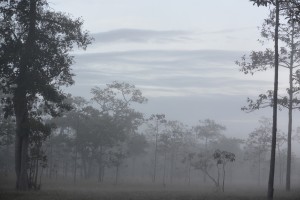 Dawn at the edge of the forest
Dawn at the edge of the forest
We’d agreed that the NBCCG’s would call leading us to their front door but damp from the night’s rain they were taking longer over their toilet than usual. We set off into the forest anyway in the hope of meeting at a favorite breakfast spot. Pockets of idyll remain and this was one of them. Like a priest in a cathedral our Gibbon conducted the service from his pulpit 10 meters above.
Sarah, a phd researcher and Naven referred to him as JII, which meant he’d built Angkor Wat. We could just make his buff cheeks (this is an objective statement). A little further and the female was spotted followed by 3 juveniles. Our breakfast was waiting on a crude table beside the trees though we’d have killed for a cup of coffee.
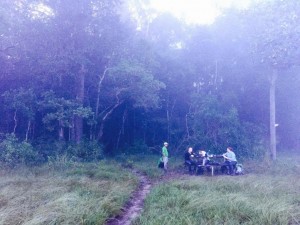 Breakfast at the edge of the forest
Breakfast at the edge of the forest
I said goodbye to Noi regretting he wasn’t my motorbike driver for the journey our through the swamps to Veunsai. The Sesan Ferry where the ferryman knocked a motorbike into the river and Dy on the other side for the drive to Banlung. One night and a big adventure felt like a lifetime as I hobbled around the spread out streets of the town.

 Greater Adjutant inside the Core Bird Reserve.
Greater Adjutant inside the Core Bird Reserve.  Cormorant and Oriental Darter colony with their white chicks. Photo Nick Butler
Cormorant and Oriental Darter colony with their white chicks. Photo Nick Butler Prek Toal Village during the flood. Photo Nick Butler
Prek Toal Village during the flood. Photo Nick Butler Kayaking at the edge of the Core Bird Reserve from finfoot. Photo Nick Butler
Kayaking at the edge of the Core Bird Reserve from finfoot. Photo Nick Butler 

 Kayaks stowed on finfoot
Kayaks stowed on finfoot








 Pit Viper in tree beside boat
Pit Viper in tree beside boat Seb and Lena setting off from their homestay
Seb and Lena setting off from their homestay Sunset over the Prek Toal Core Bird reserve
Sunset over the Prek Toal Core Bird reserve Dawn over Prek Toal
Dawn over Prek Toal

 The salapali or space for teaching of Wat Cheu Kmao
The salapali or space for teaching of Wat Cheu Kmao Grey-headed Fish Eagle
Grey-headed Fish Eagle A floating house being towed to deeper water through a village of stilted houses
A floating house being towed to deeper water through a village of stilted houses The stilted houses lining the still flooded banks of the middle Sangke River
The stilted houses lining the still flooded banks of the middle Sangke River A pagoda on the riverbank not far from Battambang
A pagoda on the riverbank not far from Battambang Psa Thmei
Psa Thmei
 Manus & Lena crossing the river and a monk house at Bovil Pagoda
Manus & Lena crossing the river and a monk house at Bovil Pagoda Nick (left), Lena & Sebastian on board a norrie
Nick (left), Lena & Sebastian on board a norrie
 Manus leading the group on the forest path to Preah Khan
Manus leading the group on the forest path to Preah Khan A forest flower
A forest flower Veasna and Buntha
Veasna and Buntha Sreymom, Manus and Try our guide
Sreymom, Manus and Try our guide Left to right; Buntha, Veasna, Pov, Try, Nick, Manus and Sreymom
Left to right; Buntha, Veasna, Pov, Try, Nick, Manus and Sreymom Prasat Preah Steung, part of the Preah Khan complex of temples
Prasat Preah Steung, part of the Preah Khan complex of temples Manus soaked in sweat after the ride
Manus soaked in sweat after the ride Ta Siem Village where we had lunch
Ta Siem Village where we had lunch The ‘road’ from Ta Bos village to BeTreed that we’d driven the night before
The ‘road’ from Ta Bos village to BeTreed that we’d driven the night before Carrying the motorbike across
Carrying the motorbike across Molly the Pileated Gibbon
Molly the Pileated Gibbon Manus the other gibbon
Manus the other gibbon The Team at the East Entrance to Preah Khan including Mengly (2nd left)
The Team at the East Entrance to Preah Khan including Mengly (2nd left) Inside Preah Khan
Inside Preah Khan The other gibbon inside Preah Khan
The other gibbon inside Preah Khan Just when we thought it was all over – heading South to Stoung
Just when we thought it was all over – heading South to Stoung A flower to finish
A flower to finish
 The Boma in Entebbe
The Boma in Entebbe Hadada Ibis on the shores of Lake Victoria
Hadada Ibis on the shores of Lake Victoria Tortoise with damaged shell at SNCC (+ me)
Tortoise with damaged shell at SNCC (+ me) Chameleon on Fred’s arm
Chameleon on Fred’s arm Simon flying us to Kahihi
Simon flying us to Kahihi The landing strip at Kahihi
The landing strip at Kahihi Ndali Lodge
Ndali Lodge Crater lake to the East
Crater lake to the East Holub’s Golden Weaver – seen walking around the crater lakes
Holub’s Golden Weaver – seen walking around the crater lakes Crater lake to the West
Crater lake to the West Totti, the alpha male
Totti, the alpha male
 The Bigodi wetlands
The Bigodi wetlands

 Queen Elizabeth National Park from my banda at Kyambura Lodge
Queen Elizabeth National Park from my banda at Kyambura Lodge Elephant below the lodge
Elephant below the lodge  My banda
My banda  The Kyambura Gorge
The Kyambura Gorge

 Left and above the Kyambura Gorge Troup
Left and above the Kyambura Gorge Troup The restaurant terrace at the lodge
The restaurant terrace at the lodge



 Young hippo and water birds along the channel
Young hippo and water birds along the channel The Ishasha Forest (there were some more trees)
The Ishasha Forest (there were some more trees) The impenetrable forest
The impenetrable forest The Munyanga Stream
The Munyanga Stream

 Boarding our Caravan at Kasese with Noemi, the Mexican tour operator
Boarding our Caravan at Kasese with Noemi, the Mexican tour operator
 Male Northern Buff Cheeked Crested Gibbon (NBCCG)
Male Northern Buff Cheeked Crested Gibbon (NBCCG) The Terres Rouge Lodge in the old Governors building
The Terres Rouge Lodge in the old Governors building The Sesan River
The Sesan River Ferry across The Sesan
Ferry across The Sesan Sresh (below) and an orchid (above)
Sresh (below) and an orchid (above)
 Koh Peap Waterfall (above) and village cemetery (right)
Koh Peap Waterfall (above) and village cemetery (right)
 Conservation International Station at Veun Sai Siem Pang
Conservation International Station at Veun Sai Siem Pang Dawn at the edge of the forest
Dawn at the edge of the forest Breakfast at the edge of the forest
Breakfast at the edge of the forest